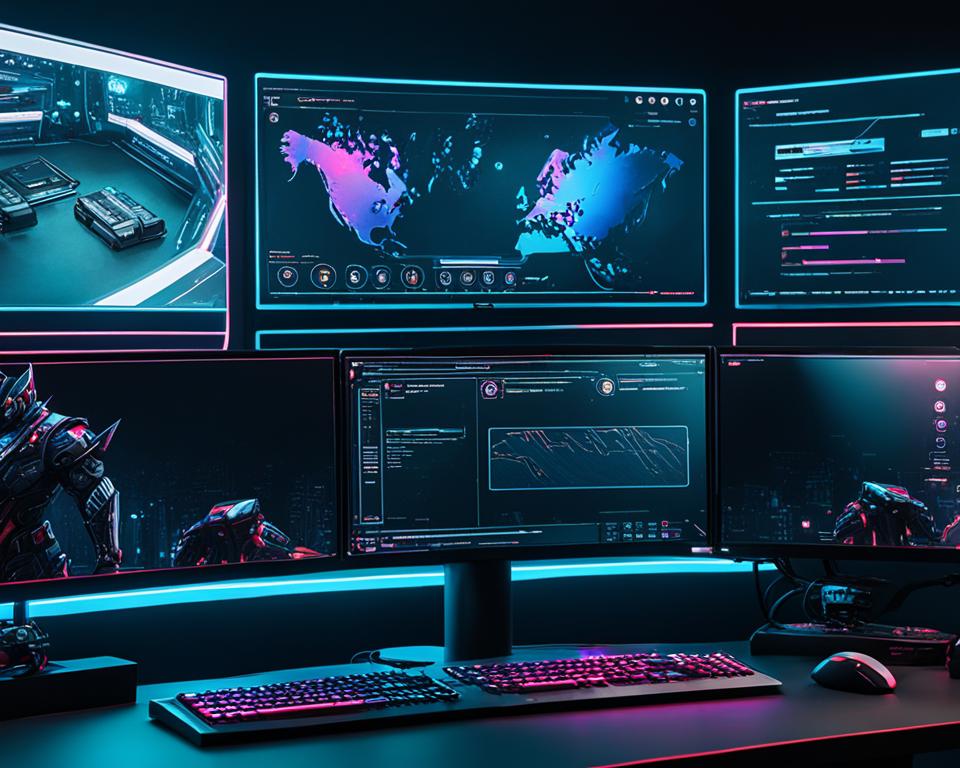In today’s fast-paced digital world, multitasking has become second nature to many of us. Whether you’re a professional working on multiple projects or a gamer looking to enhance your gaming experience, having dual monitors can be a game-changer. With dual monitors, you can have multiple display screens connected to your computer, allowing you to work efficiently and effortlessly.
Imagine this: you’re working on an important project, and you need to reference multiple documents simultaneously. With a single monitor, constantly switching between tabs becomes a hassle and slows down your workflow. Now, picture having two monitors side by side, giving you the luxury of having all your documents and applications visible at once. You can seamlessly drag and drop files, copy and paste information, and breeze through your work without missing a beat.
In the gaming world, a dual monitor setup offers an immersive experience like no other. Imagine playing your favorite game on one screen while monitoring game stats, chat boxes, or live streams on the other. You can keep an eye on your opponents, communicate with teammates, and view additional game content without interrupting your gameplay. It’s like having a panoramic view of your virtual world, putting you at a significant advantage.
But how do you set up dual monitors with both your GPU and motherboard? That’s what this comprehensive guide is all about. We will walk you through the step-by-step process, from understanding the basics of GPUs and motherboards to connecting your monitors and configuring display settings. By the end of this guide, you’ll be able to enjoy the benefits of a dual monitor setup.
Key Takeaways:
- Having dual monitors can greatly enhance your productivity and gaming experience.
- A GPU (Graphics Processing Unit) and motherboard are essential components for setting up dual monitors.
- Identify the available ports on your motherboard and GPU to ensure compatibility with your monitors.
- Connect the primary monitor to the GPU for optimal performance and connect the secondary monitor to the motherboard, if supported.
- Configure the display settings to personalize your dual monitor setup according to your preferences.
Understanding the Basics: GPU, Motherboard, and Dual Monitors
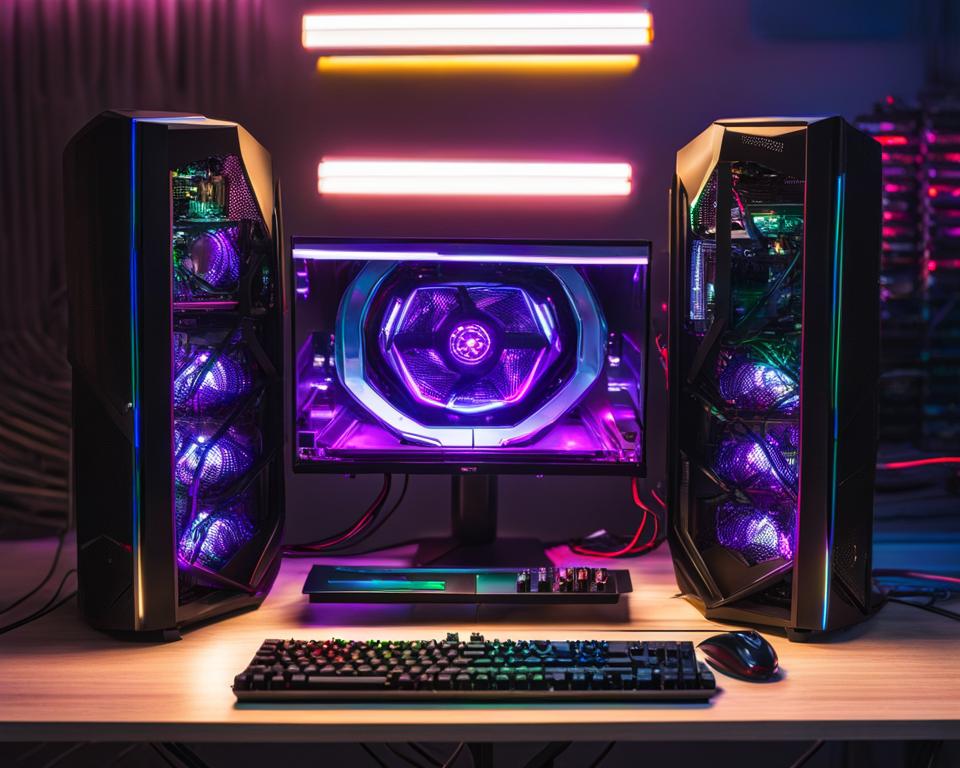
A GPU (Graphics Processing Unit) is a specialized electronic circuit responsible for rendering images and videos. It can be found in dedicated graphics cards or integrated into the motherboard itself.
The motherboard is the main circuit board of your computer, connecting all essential components. It provides the necessary communication and power for all the hardware in your system.
Dual monitors refer to the setup where two monitors are connected to the same computer, providing extended screen real estate for multitasking and productivity.
“A GPU is like the powerhouse of graphics processing, working in tandem with the motherboard to deliver visually stunning experiences. Dual monitors take this to the next level by expanding your workspace and allowing you to do more simultaneously.”
When you connect dual monitors to your GPU and motherboard, you create a versatile setup that caters to your specific needs. By utilizing the processing power of the GPU and the integrated graphics from the motherboard, you can achieve superior visuals and maximize your efficiency.
Now that we have a basic understanding of GPUs, motherboards, and dual monitors, let’s dive into the details of identifying the ports on each in the next section.
Identifying Your Motherboard and GPU Ports
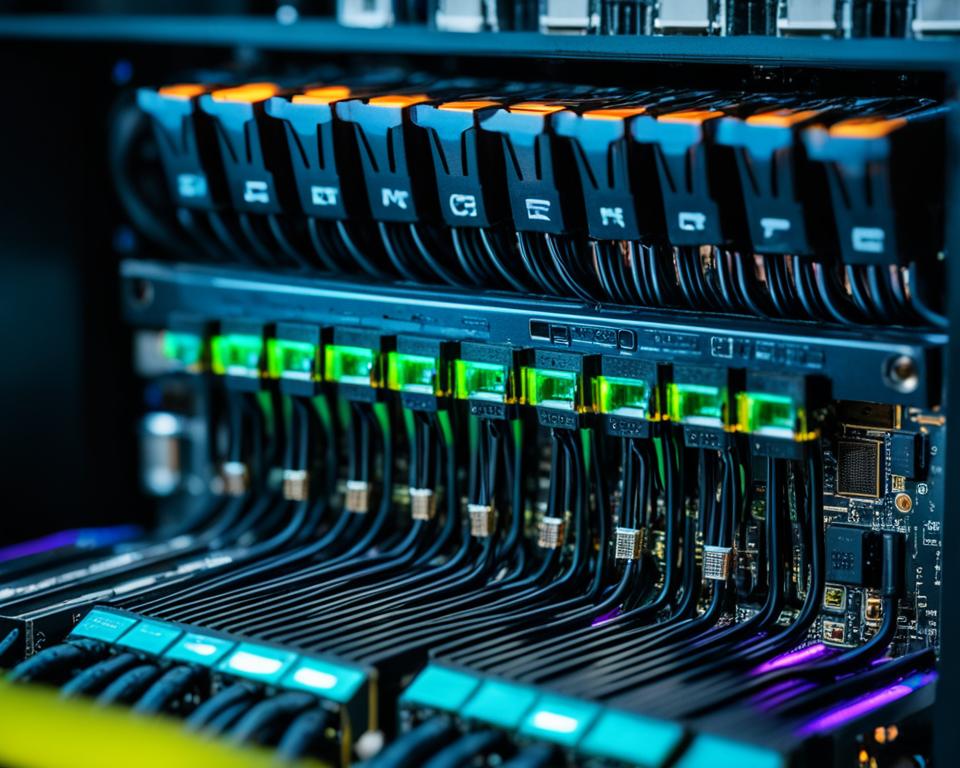
When setting up dual monitors, it is crucial to identify the ports on both your motherboard and GPU. Most modern motherboards offer various display ports, including VGA, DVI, HDMI, and DisplayPort. Likewise, GPUs also feature similar ports, although the availability may vary based on the specific model and brand.
Understanding the different motherboard and GPU ports is essential for ensuring compatibility with your monitors. Let’s take a closer look at some commonly used ports:
| Motherboard Ports | GPU Ports |
|---|---|
| VGA | VGA |
| DVI | DVI |
| HDMI | HDMI |
| DisplayPort | DisplayPort |
These ports serve as the primary means of connecting your monitors directly to either the motherboard or the GPU. However, it’s important to note that not all motherboards and GPUs will have the same port configurations, so you should consult the manuals or specifications of your specific hardware to determine which ports are available.
By properly identifying the ports on your motherboard and GPU, you can ensure a seamless and efficient dual monitor setup.
Connecting Monitors to Your GPU and Motherboard
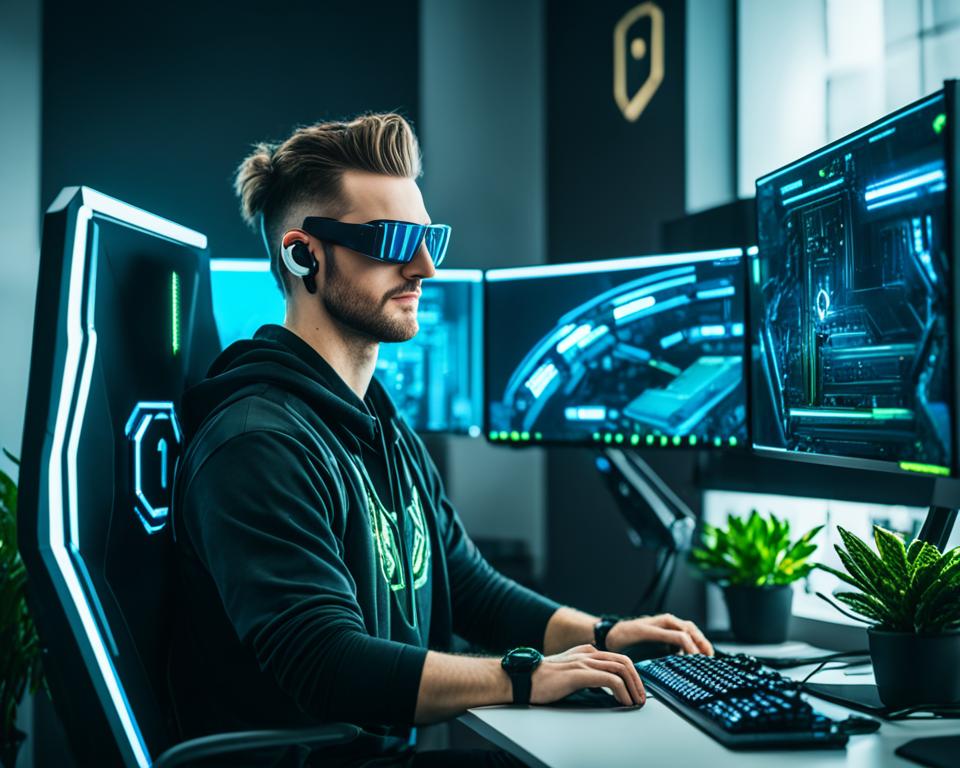
When setting up a dual monitor configuration, it is crucial to connect the monitors properly to ensure optimal performance and compatibility. In this section, we will guide you through the process of connecting your monitors to both your GPU and motherboard.
Connect Your Primary Monitor to the GPU
For the best graphics processing performance, it is recommended to connect your primary monitor directly to the GPU. The primary monitor will handle most of the graphics-intensive tasks, such as gaming or video editing. To do this, follow these steps:
- Identify the appropriate port on your GPU for the primary monitor connection. Common GPU ports include HDMI, DisplayPort, DVI, and VGA.
- Connect one end of the cable (HDMI, DisplayPort, DVI, or VGA) to the port on your GPU.
- Attach the other end of the cable to the corresponding port on your primary monitor.
By connecting your primary monitor to the GPU, you ensure that it utilizes the dedicated graphics processing power, resulting in smoother visuals and improved performance.
Connect Your Secondary Monitor to the Motherboard
If your motherboard supports integrated graphics, you can connect your secondary monitor to it. This allows you to utilize both the GPU and the motherboard’s integrated graphics for a dual monitor setup. Here’s how:
- Identify the appropriate port on your motherboard for the secondary monitor connection. Common motherboard ports include HDMI, DVI, and VGA.
- Connect one end of the cable (HDMI, DVI, or VGA) to the port on your motherboard.
- Attach the other end of the cable to the corresponding port on your secondary monitor.
By connecting your secondary monitor to the motherboard, you can offload less graphics-intensive tasks to the integrated graphics, freeing up resources on your GPU.
Remember to adjust the display settings on your computer to set up dual monitors, as described in the next section.
Configuring Display Settings for Dual Monitors
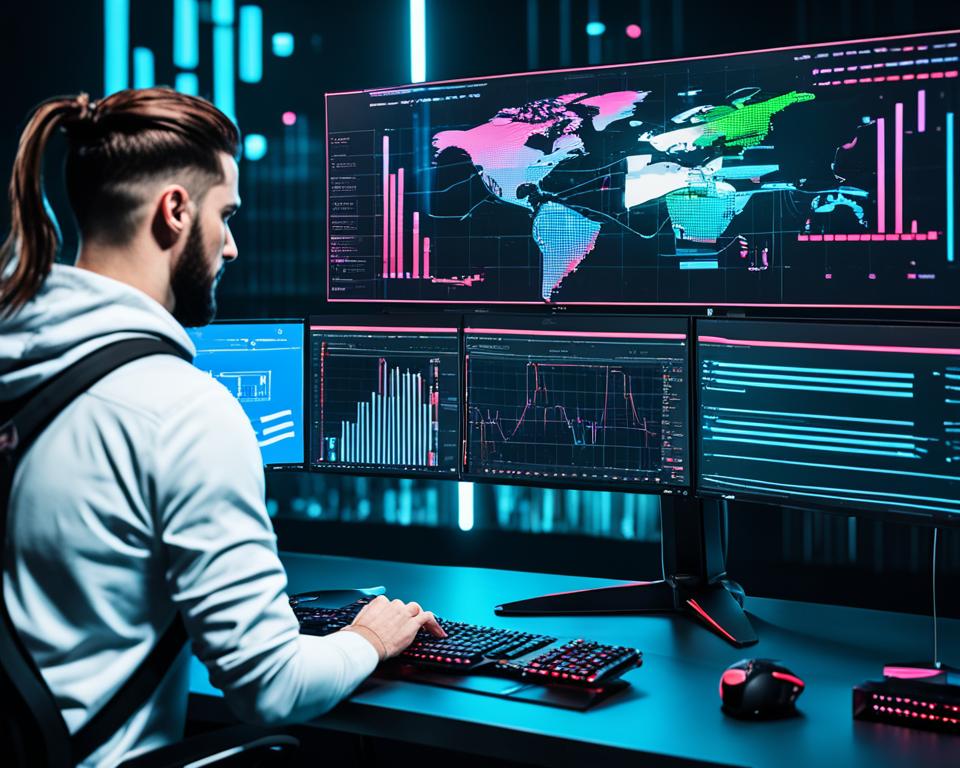
Once you have successfully connected your dual monitors, it is essential to configure the display settings to ensure they work seamlessly together. By optimizing the display settings, you can personalize your dual monitor setup according to your preferences and needs.
Identifying Primary and Secondary Monitors
To begin configuring your display settings, navigate to the display settings on your computer. Here, you will be able to identify your primary and secondary monitors. The primary display typically serves as the main screen for most of your tasks, while the secondary display provides additional workspace.
Adjusting Resolution and Orientation
Within the display settings, you can adjust critical parameters for your dual monitors, such as resolution and orientation. Resolution determines the clarity and sharpness of the content displayed on your screens. Select the desired resolution that best suits your needs.
Orientation refers to the alignment of your monitors (landscape or portrait mode). Depending on your workflow, you can choose the orientation that enhances your productivity. For example, landscape mode is ideal for tasks that require a wider screen, while portrait mode is suitable for tasks that involve reading or working with long documents.
Experiment with different resolutions and orientations to find the optimal setup that suits your individual preferences and work requirements.
Arranging Monitor Placement
In addition to adjusting resolution and orientation, you can arrange the physical placement of your dual monitors to create a seamless workflow. The position of each monitor can be customized within the display settings, allowing you to align them side by side or stack them vertically.
Consider the ergonomics of your workspace and your typical usage to determine the most comfortable and efficient monitor arrangement for your dual monitor setup.
Additional Display Settings
Depending on your operating system and graphics card software, you may have access to additional display settings. These settings can include brightness, contrast, color calibration, and more. Explore these options to further fine-tune your dual monitor experience.
Once your display settings are configured to your liking, you can enjoy the benefits of a dual monitor setup, such as increased productivity, multitasking efficiency, and a more immersive computing experience.
Troubleshooting Common Dual Monitor Setup Issues
Setting up dual monitors can be a game-changer for your productivity and multitasking needs. However, like any technical setup, you may encounter some common issues along the way. In this section, we will address the most frequent dual monitor setup issues and provide troubleshooting tips to resolve them quickly.
Black Screen
One of the most common issues when setting up dual monitors is encountering a black screen. This can be frustrating, but don’t worry, there are several steps you can take to fix it:
- Check the cable connections: Ensure that all cables connecting your monitors to the GPU and motherboard are securely plugged in.
- Update graphics drivers: Outdated or incompatible graphics drivers can cause display issues. Visit the manufacturer’s website or use dedicated software to update your graphics drivers.
- Restart your computer: Sometimes, a simple restart can resolve display problems. Restart your computer and see if the black screen issue persists.
By following these troubleshooting steps, you should be able to solve the black screen problem and enjoy your dual monitor setup without any issues.
Resolution Mismatch
Another common issue you may encounter is a resolution mismatch between your monitors. This can result in one screen appearing larger or smaller than the other, causing a visually inconsistent experience. Here’s how to address it:
- Adjust display settings: Go to the display settings on your computer and ensure that the resolutions of both monitors are set to the same value. This will ensure a uniform visual experience.
- Update graphics drivers: As mentioned earlier, updating graphics drivers can help resolve various display-related issues, including resolution mismatch. Make sure you have the latest drivers installed for your GPU.
- Check monitor settings: Some monitors have built-in settings that allow you to adjust the aspect ratio or screen size. Refer to the monitor’s user manual and make any necessary adjustments to achieve a consistent resolution.
With these troubleshooting steps, you can overcome resolution mismatch and enjoy a seamless dual monitor setup with consistent visuals.
These troubleshooting tips should help you overcome common dual monitor setup issues such as black screen problems and resolution mismatches. By addressing these issues, you can ensure a smooth and productive dual monitor experience.
The Function of a Graphics Processing Unit (GPU)
The Graphics Processing Unit (GPU) is a critical component responsible for processing and rendering graphics on your computer screen. It performs intricate calculations and optimizations to generate visuals for various applications, including gaming, video editing, and 3D modeling.
When it comes to gaming, a powerful GPU is essential for delivering smooth and immersive gameplay experiences. It handles the complex task of rendering lifelike graphics, ensuring that every detail is faithfully portrayed on your screen. Whether you’re exploring vast open worlds, engaging in intense firefights, or admiring breathtaking landscapes, a robust GPU is vital for a visually stunning gaming experience.
In the realm of video editing and image processing, a high-performance GPU significantly accelerates the rendering and manipulation of media files. Complex effects, transitions, and filters can be applied more quickly, allowing for efficient workflow and shorter project turnaround times. With a capable GPU, professionals can bring their creative visions to life with ease.
Additionally, the GPU plays a crucial role in tasks such as 3D modeling and simulation. It enables designers and engineers to visualize complex models and simulations accurately. From designing architectural structures to analyzing fluid dynamics, the GPU ensures that the computational heavy lifting is handled efficiently, resulting in realistic and precise representations.
The Role of Monitors in Displaying Graphics
Monitors play a vital role in visually representing the output generated by the GPU. These display devices come in various sizes, resolutions, and technologies, allowing users to experience digital content in stunning detail.
When connected to the GPU, monitors act as the visual interface between the user and the graphics rendered by the GPU. They provide a clear and vibrant display of images, videos, games, and other visual content, ensuring an immersive and engaging experience.
Through the collaboration of the GPU and monitors, users can witness the accurate reproduction of colors, intricate details, and smooth motion displayed on the screen. Whether it’s a professional design project, a gaming session, or simply watching multimedia, monitors serve as the medium through which the visual representation is conveyed to the user.
With advancements in technology, monitors now offer features such as high refresh rates, HDR support, and wide color gamuts, further enhancing the visual quality and overall viewing experience. These display devices are designed to provide crisp images, vibrant colors, and sharp text, ensuring that every pixel is displayed with precision.
Furthermore, monitors also offer various connectivity options such as HDMI, DisplayPort, and VGA, allowing users to easily connect and switch between different devices. This flexibility enables users to utilize monitors as the primary display for gaming consoles, laptops, or even streaming devices.
To ensure optimal performance and visual output, it is important to choose monitors with suitable specifications based on individual needs and preferences. Factors such as screen size, resolution, response time, and panel type should be considered to maximize the potential of the GPU and create an immersive viewing experience.
Monitor Specifications Comparison
| Specification | Description |
|---|---|
| Screen Size | The physical dimension of the monitor, measured diagonally in inches. |
| Resolution | The total number of pixels displayed on the screen, determining the clarity and sharpness of images. |
| Refresh Rate | The number of times the display refreshes per second, measured in Hertz (Hz), impacting the smoothness of motion. |
| Response Time | The speed at which pixels change their state, affecting the clarity of fast-moving images and reducing motion blur. |
| Panel Type | The technology used in the monitor panel, influencing factors such as color accuracy, viewing angles, and contrast ratio. |
By carefully considering these specifications, users can choose monitors that best suit their needs, ensuring optimal visual representation and an enhanced overall viewing experience.
With the combination of powerful GPUs and high-quality monitors, users can enjoy visually stunning content, whether it’s gaming, media consumption, or professional design work. The partnership between GPUs and monitors is integral to delivering immersive visual experiences and pushing the boundaries of digital content creation.
Single GPU and Multiple Monitors
In today’s multitasking world, having multiple monitors can greatly enhance productivity and provide a more immersive computing experience. While a single GPU can handle multiple monitors for tasks such as office work, web browsing, and content creation, gaming on a multi-monitor setup may vary depending on game optimization.
Some games offer excellent multi-monitor support, allowing you to expand your field of view and immerse yourself in the gaming environment. With the increased screen real estate, you can see more of the game world and gain a competitive advantage. However, it’s important to note that not all games are optimized for multi-monitor setups, and some may cause image distortion or scaling issues.
When gaming on multiple monitors, it’s crucial to consider the resources required by the game and the capabilities of your single GPU. Resource-intensive applications, such as modern games with high graphics settings, may put a significant strain on a single GPU. This can result in reduced frame rates, lower image quality, and potential performance issues.
Therefore, if you’re an avid gamer looking for the best gaming experience on a multi-monitor setup, you may consider using multiple GPUs in an SLI (NVIDIA) or CrossFire (AMD) configuration. This allows the workload to be distributed across multiple graphics cards, providing better performance and compatibility for resource-intensive gaming.
However, for most everyday tasks and non-demanding games, a single GPU can handle multiple monitors effectively. Whether you’re working on large spreadsheets, editing videos while referencing source material, or simply enjoying a multi-monitor browsing experience, a single GPU setup can cater to your needs.
Advantages of a Single GPU and Multiple Monitors:
- Enhanced productivity and multitasking capabilities
- Expanded screen real estate for better workflow
- Seamless integration of multiple applications and windows
- Better utilization of system resources
Disadvantages of a Single GPU and Multiple Monitors:
- Potential performance limitations in resource-intensive applications
- Possible image distortion or scaling issues in certain games
- Limited gaming performance compared to multi-GPU setups
| Pros | Cons |
|---|---|
| Enhanced productivity | Potential performance limitations |
| Seamless multitasking | Possible image distortion in games |
| Better utilization of resources | Limited gaming performance |
Benefits and Drawbacks of Connecting Both Monitors to the GPU
When setting up dual monitors, connecting both displays to the GPU can provide several benefits, enhancing your performance, multitasking capabilities, and gaming experience.
- Enhanced Performance: By connecting both monitors to the GPU, you can harness the full power of your graphics processing unit, ensuring smooth and lag-free performance for graphics-intensive tasks.
- Seamless Multitasking: With two monitors connected to the GPU, you can effortlessly multitask between applications, making it easier to work on multiple projects simultaneously or reference information from one screen to another.
- Immersive Gaming Experience: Gamers can immerse themselves in a larger field of view by extending their gaming experience across two monitors. This widescreen setup can enhance visual immersion and peripheral vision, providing an advantage in certain games.
However, it’s essential to consider the drawbacks that may arise from connecting both monitors to the GPU:
- GPU Overload: Running graphics-intensive applications or games on dual monitors can put a significant load on your GPU, potentially leading to increased temperatures and decreased overall performance. It’s important to ensure that your GPU can handle the workload of both monitors.
- Higher Power Consumption: Connecting multiple monitors to the GPU can result in higher power consumption, as the GPU needs to drive both displays simultaneously. This can lead to increased electricity costs and may require a higher-rated power supply for your computer.
In summary, connecting both monitors to the GPU offers benefits such as enhanced performance, seamless multitasking, and an immersive gaming experience. However, it’s crucial to consider the potential drawbacks of GPU overload and higher power consumption. Evaluating these factors will help you make an informed decision when setting up your dual monitors.
Alternatives to Connecting Both Monitors to the GPU
If connecting both monitors to the GPU is not feasible or optimal, there are alternative options available to achieve a multi-monitor setup. These alternatives include utilizing integrated graphics on the motherboard, external graphics adapters, and multi-GPU setups.
Integrated graphics: Many modern motherboards come equipped with integrated graphics capabilities. This means that you can connect one monitor directly to the motherboard using the available ports. Integrated graphics provide a basic level of graphics processing power and can be suitable for non-intensive tasks such as browsing the internet, working with documents, or watching videos.
External graphics adapters: If you require more graphics processing power or want to connect multiple monitors to your system, external graphics adapters are an excellent solution. These adapters, also known as eGPUs, are standalone devices that can be connected to your computer via USB or Thunderbolt ports. They have their own dedicated GPU, which offloads the graphics processing tasks from your system’s main GPU.
Multi-GPU setups: For users requiring high-performance graphics processing, multi-GPU setups can be a viable option. This involves installing multiple GPUs in your system and configuring them to work together, effectively splitting the workload and boosting performance. Multi-GPU setups are commonly used in gaming, video editing, and other resource-intensive applications.
To determine the best alternative for your specific needs, consider factors such as the intended use of your system, the level of graphics processing power required, and the compatibility of your hardware with the chosen alternative.
Now let’s take a closer look at each alternative:
Additional Tips for Dual Monitor Setup
When setting up your dual monitor configuration, there are several additional tips that can enhance your overall experience. Customizing your taskbar is one way to optimize your workflow. By rearranging icons, pinning frequently used applications, and adjusting the taskbar location, you can have quick access to the tools you need.
Selecting suitable wallpapers for your dual monitors is not only aesthetically pleasing but also helps improve productivity. Choose wallpapers that complement each other, so they blend seamlessly when extending your desktop. High-resolution images or wallpapers designed specifically for dual monitors can create a cohesive visual experience.
Mastering keyboard shortcuts for window management is another valuable skill. These shortcuts allow you to move windows between monitors, snap windows to specific areas, and toggle between different applications effortlessly. By reducing the need for manual dragging and resizing, you can save time and work more efficiently.
Lastly, the position and alignment of your monitors play a crucial role in optimizing viewing comfort. Position the monitors at eye level or slightly below, ensuring that the screen is at a comfortable distance. If possible, tilt and swivel the monitors to decrease any glare or reflections, providing an optimal visual experience.

